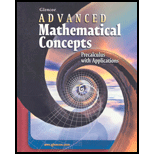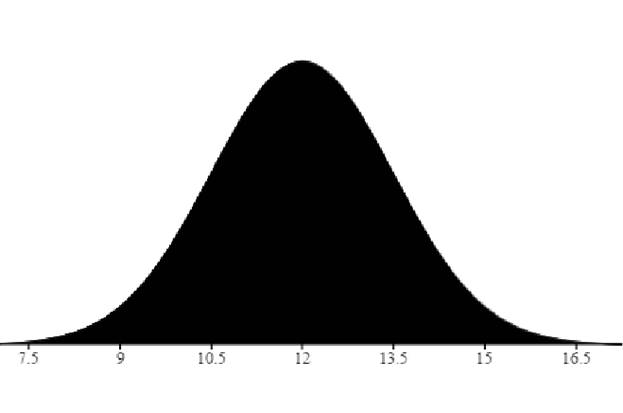
Concept explainers
(a)
To draw:
The graph of a curve that represents the frequency distribution.
(a)
Explanation of Solution
Given:
Standard deviation =1.5
Concept used:
Normal distribution: - A normal distribution is a frequency distribution that often occurs
There is a large number of values in a set of data.
The graph of this distribution is a symmetric, bell-shaped curve.
Calculation:
Normally distributed data is =12
Standard deviation =1.5
σ=1.5
Draw the graph of the frequency distribution

The frequency and probability distribution are identically shaped for a normally distributed data set.
This graph is bell curve centered at the mean /median /mode and symmetric about this point.
(b)
To find:
The interval about the mean that includes 68.3% of the data.
(b)
Answer to Problem 9E
(10.5,13.5)
Explanation of Solution
Given:
Normally distributed data is =12
Standard deviation =1.5
Concept used:
Standard deviation of a set is falls within the interval of
(m−σ,m+σ)
Calculation:
Normally distributed data is =12
Standard deviation =1.5
σ=35
68.3% Standard deviation of a set is falls within the interval of
(m−σ,m+σ) ..................(1)
Using standard deviation in equation (1)
=(m−σ,m+σ)=(10.5,13.5)
The interval about the mean that includes 68.3% of the data is (10.5,13.5)
(c)
To find:
The data is between 7.5 and 16.5 .
(c)
Answer to Problem 9E
88.7%
Explanation of Solution
Given:
Normally distributed data is =12
Standard deviation =1.5
Concept used:
Normal distribution: - A normal distribution is a frequency distribution that often occurs
There is a large number of values in a set of data.
The graph of this distribution is a symmetric, bell-shaped curve.
Calculation:
Normally distributed data is =12
Standard deviation =1.5
σ=1.5
Each of the limits in terms of the mean
12−7.5=4.516.5−12=4.5
Using the formula
ˉX±tσ=12±4.5tσ=3.5t(1.5)=4.5t=4.51.5t=3
t=3→88.7%
The values lie between 7.5 and 16.5 is 88.7% .
(d)
To find:
The data is between 9 and 15 .
(d)
Answer to Problem 9E
95.5%
Explanation of Solution
Given:
Normally distributed data is =12
Standard deviation =1.5
Concept used:
Normal distribution: - A normal distribution is a frequency distribution that often occurs
There is a large number of values in a set of data.
The graph of this distribution is a symmetric, bell-shaped curve.
Calculation:
Normally distributed data is =12
Standard deviation =1.5
σ=1.5
Each of the limits in terms of the mean
12−9=315−12=3
Using the formula
ˉX±tσ=12±3tσ=3t(1.5)=3t=31.5t=2
t=2→95.5%
The values lie between 7.5 and 16.5 is 95.5% .
Chapter 14 Solutions
Advanced Mathematical Concepts: Precalculus with Applications, Student Edition
Additional Math Textbook Solutions
Elementary Statistics (13th Edition)
University Calculus: Early Transcendentals (4th Edition)
Introductory Statistics
Thinking Mathematically (6th Edition)
Using and Understanding Mathematics: A Quantitative Reasoning Approach (6th Edition)
- What is the particular solution to the differential equation y′′ + y = 1/cos t ?arrow_forwardWhich of the following is the general solution to y′′ + 4y = e^2t + 12 sin(2t) ?A. y(t) = c1 cos(2t) + c2 sin(2t) + 1/8 e^2t − 3t cos(2t)B. y(t) = c1e^2t + c2e^−2t + 1/4 te^2t − 3t cos(2t)C. y(t) = c1 + c2e^−4t + 1/12 te^2t − 3t cos(2t)D. y(t) = c1 cos(2t) + c2 sin(2t) + 1/8 e^2t + 3 sin(2t)E. None of the above. Please include all steps! Thank you!arrow_forwardShow that i cote +1 = cosec 20 tan 20+1 = sec² O २ cos² + sin 20 = 1 using pythagon's theoremarrow_forward
- Find the general solution to the differential equationarrow_forwardcharity savings Budget for May travel food Peter earned $700 during May. The graph shows how the money was used. What fraction was clothes? O Search Submit clothes leisurearrow_forwardExercise 11.3 A slope field is given for the equation y' = 4y+4. (a) Sketch the particular solution that corresponds to y(0) = −2 (b) Find the constant solution (c) For what initial conditions y(0) is the solution increasing? (d) For what initial conditions y(0) is the solution decreasing? (e) Verify these results using only the differential equation y' = 4y+4.arrow_forward
- Aphids are discovered in a pear orchard. The Department of Agriculture has determined that the population of aphids t hours after the orchard has been sprayed is approximated by N(t)=1800−3tln(0.17t)+t where 0<t≤1000. Step 1 of 2: Find N(63). Round to the nearest whole number.arrow_forward3. [-/3 Points] DETAILS MY NOTES SCALCET8 7.4.032. ASK YOUR TEACHER PRACTICE ANOTHER Evaluate the integral. X + 4x + 13 Need Help? Read It SUBMIT ANSWER dxarrow_forwardEvaluate the limit, and show your answer to 4 decimals if necessary. Iz² - y²z lim (x,y,z)>(9,6,4) xyz 1 -arrow_forward
 Calculus: Early TranscendentalsCalculusISBN:9781285741550Author:James StewartPublisher:Cengage Learning
Calculus: Early TranscendentalsCalculusISBN:9781285741550Author:James StewartPublisher:Cengage Learning Thomas' Calculus (14th Edition)CalculusISBN:9780134438986Author:Joel R. Hass, Christopher E. Heil, Maurice D. WeirPublisher:PEARSON
Thomas' Calculus (14th Edition)CalculusISBN:9780134438986Author:Joel R. Hass, Christopher E. Heil, Maurice D. WeirPublisher:PEARSON Calculus: Early Transcendentals (3rd Edition)CalculusISBN:9780134763644Author:William L. Briggs, Lyle Cochran, Bernard Gillett, Eric SchulzPublisher:PEARSON
Calculus: Early Transcendentals (3rd Edition)CalculusISBN:9780134763644Author:William L. Briggs, Lyle Cochran, Bernard Gillett, Eric SchulzPublisher:PEARSON Calculus: Early TranscendentalsCalculusISBN:9781319050740Author:Jon Rogawski, Colin Adams, Robert FranzosaPublisher:W. H. Freeman
Calculus: Early TranscendentalsCalculusISBN:9781319050740Author:Jon Rogawski, Colin Adams, Robert FranzosaPublisher:W. H. Freeman
 Calculus: Early Transcendental FunctionsCalculusISBN:9781337552516Author:Ron Larson, Bruce H. EdwardsPublisher:Cengage Learning
Calculus: Early Transcendental FunctionsCalculusISBN:9781337552516Author:Ron Larson, Bruce H. EdwardsPublisher:Cengage Learning





